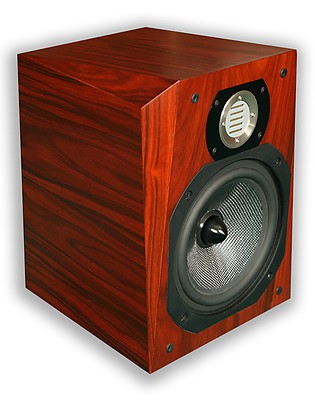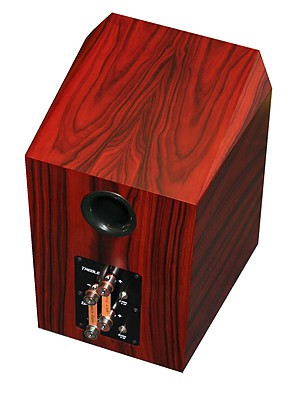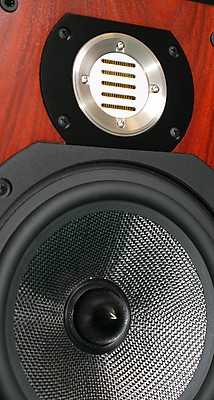Legacy Audio Studio HD
Legacy Audio has a long history as a speaker manufacturer, but for most of it’s 30 year existence, it flew somewhat under the radar of the audio press. One of the original ‘direct-to-the-customer’ manufacturers of audiophile speakers, I first discovered them through owners on audio forums back in the early 1990s who were, unsurprisingly, strong advocates of the speakers. The few published reviews I could uncover seemed equally positive, with constant references to the build quality and value for money on offer from this small-town Illinois manufacturer. I ended up visiting the company several years later as part of my search for a new speaker and spent the best part of a hugely enjoyable day with a staff member in a listening room hearing various models, even those priced beyond my reach. I subsequently purchased a pair of their Signature III’s, which stretched me as far as I could go financially at the time but which I kept for 8 very happy years before selling them on to the first person who responded to my advertisement. He literally came round with his girlfriend, listened to them for 20 minutes before making me an offer that was in line with what I was asking and a pretty good chunk of my original cost. How many audio purchases can you say this about? My abiding memory of those speakers was their great looks and rich warm sound, which my significant other loved too.
Fast-forward to RMAF 2012: Legacy Audio products are by now regular items in the audio press, the company has an increasing following, and I find myself sitting in front of an impressive range of their speakers in a huge room, waiting to hear the new Aeris make its show debut. One of the oddities of RMAF is large rooms where different speaker companies “share” the space, taking it in turns to demo their products loudly, with negotiated times allowing one to play while the other stays quiet. It probably does wonders for competitor relations but it’s a bit of a crap shoot for attendees trying to hear specific models.
The first day of any audio show is pretty chaotic. Before I realized it, a small pair of monitors, quickly placed almost casually on top of a nearby floorstander, belts out some vocal jazz so as to keep the music going for a somewhat insistent attendee. Amazingly, these little speakers filled the space well. The Legacy staff were joking that the monitor-on-floorstander location was not exactly a recommended way of placing the speakers, but we all could sense that they sounded impressive. Two months later, I have a pair of these monitors in my home for review, and while I have resisted the temptation to replicate the RMAF layout by plonking them down on top of my reference floorstanders, I have tried them in multiple configurations around my home to get some sense of how well they cope with various equipment and room layouts.

Legacy call the Studio HD a “butt kickin’ compact monitor” that consists of an 8” midwoofer paired with a 1” neo-folded ribbon tweeter in a well-crafted, 28-pound, rear-ported cabinet. Their size belies the sheer heft of these beautifully finished speakers. The dual binding posts on the rear are as solid as I’ve seen on any speaker and, as expected with Legacy, the rosewood-finished cabinets are a tactile and visual pleasure. While looks are no substitute for sonics, they certainly contribute to pride of ownership and one imagines the speakers will slide easily into most domestic set-ups without disturbing the peace. Covering a range of (an exactly specified) 41Hz to 30KHz, all within a 13” high cabinet, the Studios offer specified full performance to go with the $1500 price – but how do they work in a domestic environment?

Set up and listening
With a stated sensitivity of 93db, Legacy recommends amplification ranging from 25 to 200 watts and I took this as guidance only, running them both below and above this range. In all cases but one they were placed on my QED Tristands which place the tweeters a little below ear level, so I lowered the rear spike on each stand to aim the speaker slightly up at me in a seated position. First up, as with most speakers I audition, they get warmed up in a small-room system. This consists of my old Rotel 945 CD player, a Naim Nait II, a 15w integrated back in the day (maybe even a little less, depending on whose specifications you believe), and QED speaker wire bought to work with the Naim’s unique connections. I fed them a steady supply of jazz and rock CDs for a couple of weeks in this bedroom system.
The Naim is a sweet little amp but it is low powered and over 20 years old. While I have sympathy with the “first watt is the most important” line of audiophile reasoning, it might not surprise you to read that I don’t believe low wattage integrateds are the best way to go with the Studio HD. Despite it’s impressive specs, the speaker never opened up when driven by the Naim, with the music being pleasant enough but having a congested, somewhat thick bass response. My Elekit DIY tube amp (a lightly rated 8.5w 6L6GC tubed integrated) actually sounded better but was still not quite resolving enough in the lower frequencies although for real nearfield listening, it was a pleasant combination. That said, I don’t think either would satisfy very serious listeners for long. If you spend this kind of money on a speaker, take the manufacturer’s advice on amplification requirements seriously.
Far better was a recently purchased Harman Kardon HK3490 receiver which puts out more than 120w of clean stereo power and serves in my world as the engine for a workroom system. Now, this is a cheaper amp than the Naim, but don’t be fooled, it has serious power which it can deliver cleanly, and with very decent sonics in my experience. Again using a CD front-end (Denon 2900 via a Parasound Ultra 2000 Dac, all with MIT T2 interconnects and Speltz Anti-Cable speaker wires), as well as lengthy doses of the local public radio offerings via the HK 3490’s tuner section, the Studios could show what they were capable of delivering. Pumping out rock or jazz combos, they now sounded more like the speakers I’d heard at RMAF. In a 15 x 14ft room, this combo sounded full, warm, sufficiently resolving and dynamic. The best speakers I’d heard in that room were the Harbeth P3ESRs that I reviewed last year (but with different amplification) and memory is an unkind basis for comparison, but the Studios were certainly warmer and to my ears less resolving in some key areas (Geezer Butler’s bass and Tony Iommi’s Gibson SG lines blended a little more than I usually hear on Black Sabbath’s Heaven & Hell, losing something of their distinctive qualities). The Studios work well in this size of room with that much power on hand, and though small, if ever a speaker can be described as sounding bigger than it looked, this little Legacy earns that label.
Hitting the hard stuff
The Studios taste for clean power and quality matching components was confirmed when they found their way into my reference rig for the bulk of their time here. For sure, these are monitors but their specs, build quality and comfortable range of operation make them reasonable candidates for standalone stereo speakers in a decent set-up. Fed by components costing far more, details aplenty are revealed, particularly from the upper midrange and beyond. The Studios, when powered appropriately, portray a very lively, realistic soundstage that is beyond the physical size of their cabinets.
Playing around with location in the main listening room, I found them to work best when moved out from the front wall, eventually setting them about 8ft apart (inside edge to inside edge) with slight toe-in, their front faces slightly back from where I normally put my Von Schweikerts but closer together. I would say these speakers are relatively easy to position and once I obtained a decent center image and spread, further tweaking offered little dramatic change. I tried a couple of positions with respect to the front wall, thinking the rear port might require careful placement but I did not find this to be the case and given the layout of my racks, I prefered them out in front. I finally settled on 35” from rear of cabinet to wall, and, after biwiring them with Elrod cables from my Spectron Monos, I let them play all music, vinyl and CD, in my main room for a few weeks. During this period I listened to them from my normal seat on the couch, some 12 feet back, or from an ottoman which I moved forward and back to play with nearfield set ups.
It is sometimes said that certain speakers lend themselves to particular types of music, and while I’ve never subscribed to that theory, the Studios come closer to embodying this for me than I am comfortable admitting. Perhaps it’s the physics of cabinet size, and the somewhat inescapable limits of what one 8” woofer can provide, but the Studios are really so much more comfortable with acoustic instruments and small scale jazz combos than they are with rock. In fact, it’s almost as if the speakers take on two different characters, depending on what you are playing. For owners, this will be crucial in determining if you can get along with the Studio HD. Feed them Brad Mehldau or Keith Jarrett and they give you timbral accuracy, resolution, and air in spades. With the right recordings, even in a large room, these speakers can sound very true to life. Larry Coryell’s Shining Star is fast, spacey, driven by snappy, busy percussion and lively bass, and full of atmospheric touches, Coryell producing a stream of great solos throughout. The Studios deliver that wide soundstage and energetic, pulsing space from which the lyrical guitar lines emerge. No, they cannot match the VR5SE in terms of scale but one looks at those small cabinets and has to admit the size of the resulting sonic image is impressive.
Vocals too sound realistic and present, floating totally free of the speakers. Holly Cole is as believably Holly with these as she is with my reference VR5SEs, and the rasp of Sass Jordan’s voice on You Don’t Have to Remind Me is convincing. Articulation here is excellent, with the Studios making it easy to understand the words of singers than many other speakers I’ve heard, a sure test of quality. Solo cello comes through with body, tone, and believable dynamics, so the wonderful Isomike recording of Viktor Uzur released by Kimber last year is a joy to behold. Upper frequency details are clear and resolved. Taken as a package, these combined qualities may make you wonder how more expensive speakers justify their price tags. Nuances I’d detected on more expensive speakers, such as the cymbal interplay on Tord Gustavsen Trio’s Being There, were not lost on the Studios, creating the impression for me at least that in some ways, the speakers are the equal of far more expensive models I’ve heard.
Push them harder with more heavily amplified work, such as Rory Gallagher’s excellently remastered Calling Card on Sony, or Stevie Ray Vaughn’s Coundn’t Stand the Weather, and the limitations of the Studios as main stereo speakers start to be apparent. Bass, in particular, proved limiting in all my set-ups. It is present with the Studios but not as well defined as I am used to hearing. With some speakers, this is a graceful trade-off, a sin of omission, as the lower frequencies fade out rather than drop suddenly, but the Studios attempt to deliver strong low bass and sometimes they just cannot get it out. On driving rock, bass can overwhelm or lag behind the nimble response of the upper frequencies, flattening the musical experience and robbing it of life in an important way. Where the uppers and mids bloom, the bass often sounds leaden and tubby, restricting the music’s rhythm and drive and hardening the musical presentation. This is far less noticeable on orchestral recordings (though scale here can be reduced), and is not really an issue for most jazz-vocals or folk, but it is to my ears a real limitation for rock. At the price, some might consider this limitation to be fatal but that depends on your reference points and musical preferences. The Studios have a neat little feature, two rear switches that trim the bass or treble extremes by 2db. I remember these from my time with the Sig IIIs and while I left the uppers untrimmed, invoking the switch for bass helped a little with overall bass sound in my rig, so I left it on for rock listening.
I suspect that the Studios ideal system match requires the use of a subwoofer or perhaps limiting their use to small rooms or (ahem) studio environments (they are, to my mind, a little too large and heavy for desktop duties unless you have a massive desk, though they do work well for nearfield listening). Assuming one could integrate a sub easily (which I could not test as I don’t run one) I imagine that by freeing up the Studios to handle the frequencies with which it is most comfortable, you could put together a truly pleasing set up, as there are many qualities to the Studios’ other areas of reproduction that are most impressive. Without a sub, I am of the view that there are limits to how and where you can use the Studios effectively as your main speakers.
Conclusion
I’ve admired and owned Legacy speakers so I am happy the company continues to deliver, in its own inimitable way, a full range of offerings for audiophiles. The Studio HDs are not for everyone but if you love certain musical styles and have a desire for high quality sonics in an easy to use, good looking, well made small speaker, I imagine your satisfaction will be assured. Amplify appropriately, get some stands, and you have a great set up in most small to medium-sized rooms for most types of music, but less so (in my view) for rock. They soundstage extremely well, offer great resolution across most of the important frequency ranges, good timbre and easy placement. I have little experience with competitors at this price point. The Harbeths that I love are $600 more, money that would comfortably enable you to purchase an amplifier or other component to front the Studios, maybe even that subwoofer that could make all the difference. I’d like to hear the Studios partnered with Legacy’s own Metro sub as they would form a $3k speaker system that might really kick butt, but then you are in Von Schweikert VR-22 territory price-wise, where the sonics on offer start to approach the best. Stiff competition, but what the Studios do right suggests to me there is a jewel in here that might be worthy of an audiophile’s efforts at polishing.
 Specifications
Specifications
- Price: $1495, cherry, other finishes available
- Tweeter: 1” Neo Folded Ribbon
- Midwooder: 8” Carbon Fiber
- Low Frequency Alignment: B4 Reflex
- Frequency Response (Hz +/- 2dB): 41-22k
- Impedance: 4 Ohms
- Sensitivity (Room, dB@2.83V): 93 dB
- Recommended Amplification: 25 – 300 Watts
- Crossover: 2.8 kHz
- Binding Posts: 2 Pair
- Weight: 28lbs
- Dimensions: W:10.8” D: 10.8″ H: 13″
Associated Equipment
- Digital: PS Audio PWT/PWD combo with Harmonic Tech HDMI connector, Denon 2900/Parasound DAC 2000 Ultra, Rotel 945AX, Tara RSC coaxial.
- Vinyl: SME 20/2, Harmonic Tech phono cable to Whest 0.03RDT phono stage.
- Preamp: SMC Audio VTE-1
- Amps: Spectron Musician III Mk 2 Monos, Harman Kardon BK3490 receiver, Naim Nait II
- Speaker wire: Elrod, Speltz Anti-Cables,
- Power cords: Elrod, Genesis Technology, Spectron Thunderbolts



